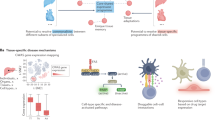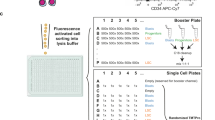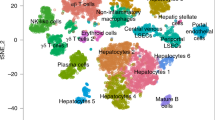Abstract
Here we present a compendium of single-cell transcriptomic data from the model organism Mus musculus that comprises more than 100,000 cells from 20 organs and tissues. These data represent a new resource for cell biology, reveal gene expression in poorly characterized cell populations and enable the direct and controlled comparison of gene expression in cell types that are shared between tissues, such as T lymphocytes and endothelial cells from different anatomical locations. Two distinct technical approaches were used for most organs: one approach, microfluidic droplet-based 3′-end counting, enabled the survey of thousands of cells at relatively low coverage, whereas the other, full-length transcript analysis based on fluorescence-activated cell sorting, enabled the characterization of cell types with high sensitivity and coverage. The cumulative data provide the foundation for an atlas of transcriptomic cell biology.
This is a preview of subscription content, access via your institution
Access options
Access Nature and 54 other Nature Portfolio journals
Get Nature+, our best-value online-access subscription
$29.99 / 30 days
cancel any time
Subscribe to this journal
Receive 51 print issues and online access
$199.00 per year
only $3.90 per issue
Buy this article
- Purchase on SpringerLink
- Instant access to full article PDF
Prices may be subject to local taxes which are calculated during checkout





Similar content being viewed by others
Data availability
All data, protocols and analysis scripts from the Tabula Muris are shared as a public resource (http://tabula-muris.ds.czbiohub.org/). Gene counts and metadata for FACS (https://doi.org/10.6084/m9.figshare.5829687.v7) and microfluidic droplets (https://doi.org/10.6084/m9.figshare.5968960.v2) from all single cells along with all produced R objects (https://doi.org/10.6084/m9.figshare.5821263.v1), as well as FACS Index data (https://doi.org/10.6084/m9.figshare.5975392) are accessible on Figshare (https://figshare.com/projects/Tabula_Muris_Transcriptomic_characterization_of_20_organs_and_tissues_from_Mus_musculus_at_single_cell_resolution/27733), and raw data are available from the Gene Expression Omnibus (GSE109774).
References
Alberts, B. et al. Essential Cell Biology (W.W. Norton & Company, New York, 2016).
Guo, G. et al. Resolution of cell fate decisions revealed by single-cell gene expression analysis from zygote to blastocyst. Dev. Cell 18, 675–685 (2010).
Dalerba, P. et al. Single-cell dissection of transcriptional heterogeneity in human colon tumors. Nat. Biotechnol. 29, 1120–1127 (2011).
Thorsen, T., Roberts, R. W., Arnold, F. H. & Quake, S. R. Dynamic pattern formation in a vesicle-generating microfluidic device. Phys. Rev. Lett. 86, 4163–4166 (2001).
Macosko, E. Z. et al. Highly parallel genome-wide expression profiling of individual cells using nanoliter droplets. Cell 161, 1202–1214 (2015).
Klein, A. M. et al. Droplet barcoding for single-cell transcriptomics applied to embryonic stem cells. Cell 161, 1187–1201 (2015).
Ramsköld, D. et al. Full-length mRNA-seq from single-cell levels of RNA and individual circulating tumor cells. Nat. Biotechnol. 30, 777–782 (2012).
Wu, A. R. et al. Quantitative assessment of single-cell RNA-sequencing methods. Nat. Methods 11, 41–46 (2014).
Treutlein, B. et al. Reconstructing lineage hierarchies of the distal lung epithelium using single-cell RNA-seq. Nature 509, 371–375 (2014).
Enge, M. et al. Single-cell analysis of human pancreas reveals transcriptional signatures of aging and somatic mutation patterns. Cell 171, 321–330.e14 (2017).
Halpern, K. B. et al. Single-cell spatial reconstruction reveals global division of labour in the mammalian liver. Nature 542, 352–356 (2017).
Haber, A. L. et al. A single-cell survey of the small intestinal epithelium. Nature 551, 333–339 (2017).
Villani, A.-C. et al. Single-cell RNA-seq reveals new types of human blood dendritic cells, monocytes, and progenitors. Science 356, eaah4573 (2017).
Darmanis, S. et al. A survey of human brain transcriptome diversity at the single cell level. Proc. Natl Acad. Sci. USA 112, 7285–7290 (2015).
Gokce, O. et al. Cellular taxonomy of the mouse striatum as revealed by single-cell RNA-seq. Cell Rep. 16, 1126–1137 (2016).
Usoskin, D. et al. Unbiased classification of sensory neuron types by large-scale single-cell RNA sequencing. Nat. Neurosci. 18, 145–153 (2015).
Zeisel, A. et al. Cell types in the mouse cortex and hippocampus revealed by single-cell RNA-seq. Science 347, 1138–1142 (2015).
Li, H. et al. Classifying Drosophila olfactory projection neuron subtypes by single-cell RNA sequencing. Cell 171, 1206–1220.e22 (2017).
Bakken, T. et al. Cell type discovery and representation in the era of high-content single cell phenotyping. BMC Bioinformatics 18 (Suppl 17), 559 (2017).
Han, X. et al. Mapping the mouse cell atlas by microwell-seq. Cell 172, 1091–1107.e17 (2018).
Freytag, S., Tian, L., Lonnstedt, I., Ng, M. & Bahlo, M. Comparison of clustering tools in R for medium-sized 10x Genomics single-cell RNA-sequencing data. F1000Res 7, 1297 (2018).
Holling, T. M., Schooten, E. & van Den Elsen, P. J. Function and regulation of MHC class II molecules in T-lymphocytes: of mice and men. Hum. Immunol. 65, 282–290 (2004).
Reichardt, J. & Bornholdt, S. Statistical mechanics of community detection. Phys. Rev. E 74, 016110 (2006).
van den Brink, S. C. et al. Single-cell sequencing reveals dissociation-induced gene expression in tissue subpopulations. Nat. Methods 14, 935–936 (2017).
Alemany, A., Florescu, M., Baron, C. S., Peterson-Maduro, J. & van Oudenaarden, A. Whole-organism clone tracing using single-cell sequencing. Nature 556, 108–112 (2018).
Cao, J. et al. Comprehensive single-cell transcriptional profiling of a multicellular organism. Science 357, 661–667 (2017).
Liu, Z. et al. Single-cell transcriptomics reconstructs fate conversion from fibroblast to cardiomyocyte. Nature 551, 100–104 (2017).
Darmanis, S. et al. Single-cell RNA-seq analysis of infiltrating neoplastic cells at the migrating front of human glioblastoma. Cell Rep. 21, 1399–1410 (2017).
Kassambara, A. Practical guide to cluster analysis in R: unsupervised machine learning 1st edn (CreateSpace, North Charleston, 2017).
Díaz-Uriarte, R. & Alvarez de Andrés, S. Gene selection and classification of microarray data using random forest. BMC Bioinformatics 7, 3 (2006).
Acknowledgements
We thank Sony Biotechnology for making an SH800S instrument available for this project. Some of the cell sorting/flow cytometry analysis for this project was performed using a Sony SH800S instrument in the Stanford Shared FACS Facility. Some FACS experiments used instruments in the VA Flow Cytometry Core, which is supported by the US Department of Veterans Affairs, Palo Alto Veterans Institute for Research and the National Institutes of Health. This work was supported by the Chan Zuckerberg Biohub, NIH Grant DP1 AG053015 and the NOMIS Foundation (T.W.-C.) as well as partly by the Stanford Islet Research Core in the Stanford Diabetes Research Center (P30 DK116074). We thank A. McGeever for contributions to the design of the Tabula Muris web portal.
Author information
Authors and Affiliations
Consortia
Contributions
See author list for full contributions.
Corresponding authors
Ethics declarations
Competing interests
The authors declare no competing interests.
Additional information
Publisher’s note: Springer Nature remains neutral with regard to jurisdictional claims in published maps and institutional affiliations.
Extended data figures and tables
Extended Data Fig. 1 The number and type of FACS cells that compose each organ.
a, Cells for each organ visualized with t-SNE, coloured by cell type. Cell types were determined by differential gene expression of known markers between clusters. b, Bar plots quantifying the number of each annotated cell type. Cell type colours match their respective t-SNE plot.
Extended Data Fig. 2 The number and type of microfluidic cells that compose each organ.
a, t-SNE plot of all cells collected by the microfluidic-droplet method, coloured by organ, overlaid with the predominant cell type that composes each cluster. b, Cells for each organ visualized with t-SNE, coloured by cell type. Cell types were determined by differential gene expression of known markers between clusters. c, Bar plots quantifying the number of each annotated cell type. Cell type colours match their respective t-SNE plot.
Extended Data Fig. 3 The number of reads, UMIs and genes detected per cell for each organ.
a, c, Histograms for each organ of the number of reads per cell (FACS) (a) and UMIs per cell (microfluidic droplet) (c). b, d, Histogram of the number of genes detected per cell for each organ from the FACS method (b), and the microfluidic-droplet method (d).
Extended Data Fig. 4 Graphical representation of cell ontology class representation.
a, b, Datasets from the FACS method (a) and the microfluidic-droplet method (b), coloured by the relative amount of each cell type in each dataset.
Extended Data Fig. 5 Methodological comparison of detected genes and library saturation.
a, The number of genes detected (threshold of >0 reads or UMIs per cell) by FACS (red; n = 21,105 individual cells), microfluidic-droplet (green; n = 55,032 individual cells) and microwell-seq (blue; n = 25,891 individual cells) methods20. b, Library saturation fraction for all microfluidic-droplet libraries. Dotted horizontal line demarcates the median saturation (around 0.9). c, Library saturation for all FACS libraries. Saturation was calculated using the number of detected genes while downsampling the number of reads per library. Summary statistics are contained in Supplementary Table 6.
Extended Data Fig. 6 The number of detected genes decreases similarly across organs as the read or UMI threshold is increased.
Fraction of all detected genes (defined as >0 reads or UMIs) for each cell, across all organs, detected at increasing read or UMI thresholds for FACS (left; n = 44,949 individual cells), microfluidic-droplet (middle; n = 55,656 individual cells), and microwell-seq (right; n = 28,372 individual cells) methods. Summary statistics are contained in Supplementary Table 6.
Extended Data Fig. 7 The number of differentially expressed genes for each cell type that are common between methods.
Venn diagrams showing the overlap between differentially expressed genes for each common cell type across the three methods (FACS, microfluidic-droplet and microwell-seq). Plotted data are provided in tabular form in Supplementary Table 2.
Extended Data Fig. 8 t-SNE visualization of all FACS cells by cluster ID.
n = 44,949 individual cells. Clusters are discussed in the text and further analysed in Fig. 3.
Extended Data Fig. 9 Metrics of cluster heterogeneity.
a, Bar plot showing the heterogeneity score for each cluster containing several cell types. b–g, Heat maps showing the average between-cell-type distances within select clusters, normalized so that the average distance between pairs of FACS cells is 1, clipped to a max of 1, for clusters 1 (b), 2 (c), 3 (d), 24 (e), 48 (f) and 53 (g).
Extended Data Fig. 10 Contribution of transcription factors to cell identity.
a, Tanglegram contrasting the dendrogram obtained using all expressed genes with one obtained using only the expression of transcription factors. The solid lines indicate segments that did not change position during the alignment between the two trees, and the dotted lines correspond to dendrogram branches reordered during the entanglement calculations. The colours indicate the branches for which identical leaves are aligned in both dendrograms. b–e, t-SNE visualization of epithelial (b), endothelial (c), B cells (d) and T cells (e), coloured by organ. f–i, t-SNE visualization of epithelial (f), endothelial (g) B cell (h) and T cell (i) expression of select transcription factors (from grey, low, to red, high). In b–i, n = 60 randomly selected cells for each cell type.
Extended Data Fig. 11 Dissociation-induced gene-expression scores for each organ analysed with FACS.
The dissociation score for each organ represents the magnitude of the first principal component of the 140 dissociation-associated genes from ref. 24. The y axis shows the probability density of the normalized histogram.
Supplementary information
Supplementary Information
A detailed discussion of organ cell types.
Supplementary Information
Cell type descriptions and differentially expressed genes analyzed for each organ and tissue.
Supplementary Information
Organ Annotation Vignette - an annotated example of organ annotation procedure.
Supplementary Table 1
Number of cells belonging to each annotated cell type across all organs for FACS and microfluidic droplets.
Supplementary Table 2
Cell type comparisons and lists of differentially expressed genes common between methods (FACS, droplet, microwell-Seq).
Supplementary Table 3
Random forest results for simultaneously defining all cell types with TF expression. This table consists of 4 tabs. The first tab summarizes the most important variables for the model. The second tab indicates all the unique cell types being classified. To build this model we used a data subset of 10 cells for each of the unique cell types. The third tab contains the classification confusion matrix and the fourth tab the summary of the average classification error per cell type.
Supplementary Table 4
Random forest results for defining each individual cell type with TF expression. In this model, each unique cell type (112 total) was compared to all other cell types. The numbers are the mean decrease Gini score. The value NA in each cell means that the transcription factor corresponding to that row does not contribute the classification model of the cell corresponding to that column.
Supplementary Table 5
Literature review of the current successful reprogramming protocols in the mouse and respective comparisons with the TF’s expression in the FACS dataset.
Supplementary Table 6
Summary statistics for Extended Data Figures 5 and 6.
Rights and permissions
About this article
Cite this article
The Tabula Muris Consortium., Overall coordination., Logistical coordination. et al. Single-cell transcriptomics of 20 mouse organs creates a Tabula Muris. Nature 562, 367–372 (2018). https://doi.org/10.1038/s41586-018-0590-4
Received:
Accepted:
Published:
Issue Date:
DOI: https://doi.org/10.1038/s41586-018-0590-4



